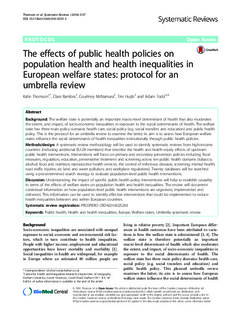| dc.contributor.author | Thomson, Katie | |
| dc.contributor.author | Bambra, Clare | |
| dc.contributor.author | McNamara, Courtney L. | |
| dc.contributor.author | Huijts, Tim | |
| dc.contributor.author | Todd, Adam | |
| dc.date.accessioned | 2020-03-04T12:01:46Z | |
| dc.date.available | 2020-03-04T12:01:46Z | |
| dc.date.created | 2016-04-25T01:32:33Z | |
| dc.date.issued | 2016 | |
| dc.identifier.citation | Systematic Reviews. 2016, 5 (57), . | nb_NO |
| dc.identifier.issn | 2046-4053 | |
| dc.identifier.uri | http://hdl.handle.net/11250/2645205 | |
| dc.description.abstract | Background
The welfare state is potentially an important macro-level determinant of health that also moderates the extent, and impact, of socio-economic inequalities in exposure to the social determinants of health. The welfare state has three main policy domains: health care, social policy (e.g. social transfers and education) and public health policy. This is the protocol for an umbrella review to examine the latter; its aim is to assess how European welfare states influence the social determinants of health inequalities institutionally through public health policies.
Methods/design
A systematic review methodology will be used to identify systematic reviews from high-income countries (including additional EU-28 members) that describe the health and health equity effects of upstream public health interventions. Interventions will focus on primary and secondary prevention policies including fiscal measures, regulation, education, preventative treatment and screening across ten public health domains (tobacco; alcohol; food and nutrition; reproductive health services; the control of infectious diseases; screening; mental health; road traffic injuries; air, land and water pollution; and workplace regulations). Twenty databases will be searched using a pre-determined search strategy to evaluate population-level public health interventions.
Discussion
Understanding the impact of specific public health policy interventions will help to establish causality in terms of the effects of welfare states on population health and health inequalities. The review will document contextual information on how population-level public health interventions are organised, implemented and delivered. This information can be used to identify effective interventions that could be implemented to reduce health inequalities between and within European countries. | nb_NO |
| dc.language.iso | eng | nb_NO |
| dc.publisher | BMC (part of Springer Nature) | nb_NO |
| dc.rights | Navngivelse 4.0 Internasjonal | * |
| dc.rights.uri | http://creativecommons.org/licenses/by/4.0/deed.no | * |
| dc.title | The effects of public health policies on population health and health inequalities in European welfare states: protocol for an umbrella review | nb_NO |
| dc.type | Journal article | nb_NO |
| dc.type | Peer reviewed | nb_NO |
| dc.description.version | publishedVersion | nb_NO |
| dc.source.pagenumber | 9 | nb_NO |
| dc.source.volume | 5 | nb_NO |
| dc.source.journal | Systematic Reviews | nb_NO |
| dc.source.issue | 57 | nb_NO |
| dc.identifier.doi | 10.1186/s13643-016-0235-3 | |
| dc.identifier.cristin | 1352127 | |
| dc.description.localcode | © 2016 Thomson et al. Open Access This article is distributed under the terms of the Creative Commons Attribution 4.0 International License (http://creativecommons.org/licenses/by/4.0/) | nb_NO |
| cristin.unitcode | 194,67,25,0 | |
| cristin.unitname | Institutt for sosiologi og statsvitenskap | |
| cristin.ispublished | true | |
| cristin.fulltext | original | |
| cristin.qualitycode | 1 | |

